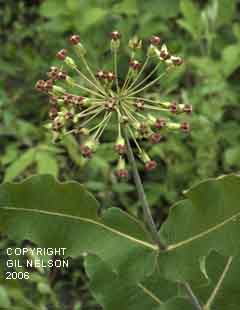Difference between revisions of "Asclepias amplexicaulis"
Ruthstetler (talk | contribs) |
Ruthstetler (talk | contribs) |
||
| Line 27: | Line 27: | ||
==Ecology== | ==Ecology== | ||
===Habitat=== <!--Natural communities, human disturbed habitats, topography, hydrology, soils, light, fire regime requirements for removal of competition, etc.--> | ===Habitat=== <!--Natural communities, human disturbed habitats, topography, hydrology, soils, light, fire regime requirements for removal of competition, etc.--> | ||
| − | + | ''Asclepias amplexicaulis'' is found on the upper slopes of longleaf pine-wiregrass flatwoods, and in mixed pine-hardwood habitat, open sand pine woodlands, and longleaf pine-oak-wiregrass sandhill communities (FSU Herbarium). It prefers high light levels associated with open woodlands and dry sandy soils such as loamy sand (FSU Herbarium). It can also appear in human disturbed areas like clearings and roadsides (FSU Herbarium). | |
| + | |||
===Phenology=== <!--Timing off flowering, fruiting, seed dispersal, and environmental triggers. Cite PanFlora website if appropriate: http://www.gilnelson.com/PanFlora/ --> | ===Phenology=== <!--Timing off flowering, fruiting, seed dispersal, and environmental triggers. Cite PanFlora website if appropriate: http://www.gilnelson.com/PanFlora/ --> | ||
Flowers from spring to summer (Wunderlin and Hansen 2011). In Florida, it has been observed flowering in April and May, specifically (FSU Herbarium). Fruiting has been observed in June and July (FSU Herbarium). | Flowers from spring to summer (Wunderlin and Hansen 2011). In Florida, it has been observed flowering in April and May, specifically (FSU Herbarium). Fruiting has been observed in June and July (FSU Herbarium). | ||
Revision as of 19:21, 8 July 2015
| Asclepias amplexicaulis | |
|---|---|

| |
| photo by Gil Nelson | |
| Scientific classification | |
| Kingdom: | Plantae |
| Division: | Magnoliophyta - Flowering plants |
| Class: | Magnoliopsida - Dicotyledons |
| Order: | Gentianales |
| Family: | Asclepiadaceae |
| Genus: | Asclepias |
| Species: | A. amplexicaulis |
| Binomial name | |
| Asclepias amplexicaulis Sm. | |

| |
| Natural range of Asclepias amplexicaulis from USDA NRCS Plants Database. | |
Contents
Description
Common names: Clasping Milkweed, Sand Milkweed
Weakley (2015) mentions that the aroma of the inflorescence smells of cloves and roses.
Distribution
Found as north as New Hampshire and New York, then west to Kansas, south to Texas Florida (Weakley 2015). In Florida, it’s found in south to central peninsula (Weakley 2015).
Ecology
Habitat
Asclepias amplexicaulis is found on the upper slopes of longleaf pine-wiregrass flatwoods, and in mixed pine-hardwood habitat, open sand pine woodlands, and longleaf pine-oak-wiregrass sandhill communities (FSU Herbarium). It prefers high light levels associated with open woodlands and dry sandy soils such as loamy sand (FSU Herbarium). It can also appear in human disturbed areas like clearings and roadsides (FSU Herbarium).
Phenology
Flowers from spring to summer (Wunderlin and Hansen 2011). In Florida, it has been observed flowering in April and May, specifically (FSU Herbarium). Fruiting has been observed in June and July (FSU Herbarium).
Seed dispersal
Seed bank and germination
Fire ecology
Present in burned areas (FSU Herbarium).
Pollination
Use by animals
Diseases and parasites
Conservation and Management
Cultivation and restoration
Photo Gallery
References and notes
Florida State University Robert K. Godfrey Herbarium database. URL: http://herbarium.bio.fsu.edu. Last accessed: June 2014.
Collectors: Loran C. Anderson, Robert K. Godfrey, Sidney McDaniel, R. A. Norris, Richard R. Clinebell II, Travis MacClendon, Karen MacClendon, and G. Wilder.
States and Counties: Florida: Washington, Franklin, Leon, Okaloosa, Holmes, Wakulla, Calhoun, and Jackson. Georgia: Thomas.
Weakley, Alan S. Flora of the Southern and Mid-Atlantic States: Working Draft of 21 May 2015. University of North Carolina Herbarium (NCU). PDF. 931.
Wunderlin, Richard P. and Bruce F. Hansen. Guide to the Vascular Plants of Florida. Third edition. 2011. University Press of Florida: Gainesville/Tallahassee/Tampa/Boca Raton/Pensacola/Orlando/Miami/Jacksonville/Ft. Myers. 270. Print.